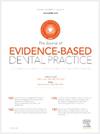PREDICTORS OF HEALTH-RELATED QUALITY OF LIFE IN TEMPOROMANDIBULAR DISORDER PATIENTS: 8-YEAR COHORT STUDY
IF 4
4区 医学
Q1 DENTISTRY, ORAL SURGERY & MEDICINE
引用次数: 0
Abstract
Objectives
This study aimed to identify baseline factors that predict Health-Related Quality of Life (HRQoL) in patients with TMD 8 years later.
Materials and Methods
401 participants (333 women, mean age 45.8 years) from a multicenter cohort were examined using the Diagnostic Criteria for TMD (DC/TMD) and questionnaires. The main outcome was the 12-item Short Form Health Survey (SF-12), a HRQoL measure that provides physical (PCS) and mental (MCS) summaries. Baseline predictors included age, gender, self-reported health, Jaw Functional Limitation Scale (JFLS), pain intensity, pain frequency, and pain duration. Regression analysis with stepwise modeling identified predictive factors.
Results
54.3% had painful TMD, 15.7% had nonpainful TMD, and 27.7% were healthy controls. For the painful TMD group, the regression model was significant (R² = .25, F = 4.3, P < .01), with age and favorable general health predicting PCS scores. In the nonpainful TMD group, the model was significant (R² = .58, F = 3.8, P < .01), with JFLS and favorable general health (predicting PCS scores. The MCS model was significant in healthy controls (R2 = .22, F = 1.8, P = .05), with JFLS as only predictor.
Conclusion
Predictors of mental HRQoL: JFLS in healthy controls, but no predictors were found in TMD groups. Predictors of physical HRQoL: General health in both TMD groups, JFLS in the nonpainful TMD group, and age in the painful TMD group.
颞下颌障碍患者健康相关生活质量的预测因素:8年队列研究
目的:本研究旨在确定预测TMD患者8年后健康相关生活质量(HRQoL)的基线因素。材料和方法采用TMD诊断标准(DC/TMD)和问卷调查对来自多中心队列的401名参与者(333名女性,平均年龄45.8岁)进行检查。主要结果是12项简短健康调查(SF-12),这是一种提供身体(PCS)和精神(MCS)总结的HRQoL测量。基线预测指标包括年龄、性别、自我报告的健康状况、颌骨功能限制量表(JFLS)、疼痛强度、疼痛频率和疼痛持续时间。结果疼痛性TMD占54.3%,非疼痛性TMD占15.7%,健康对照占27.7%。疼痛性TMD组回归模型显著(R² = )。25、F = 4.3,P <;.01),年龄和良好的总体健康状况预测PCS得分。在非疼痛性TMD组,模型显著(R² = )。58、F = 3.8,P <;.01), JFLS和良好的一般健康状况(预测PCS评分)。MCS模型在健康对照组中显著(R2 = )。22, F = 1.8,P = .05),JFLS是唯一的预测因子。结论精神HRQoL的预测因素:健康对照组为JFLS, TMD组无预测因素。躯体HRQoL的预测因素:两个TMD组的一般健康状况,非疼痛性TMD组的JFLS,以及疼痛性TMD组的年龄。
本文章由计算机程序翻译,如有差异,请以英文原文为准。
求助全文
约1分钟内获得全文
求助全文
来源期刊

Journal of Evidence-Based Dental Practice
DENTISTRY, ORAL SURGERY & MEDICINE-
CiteScore
6.00
自引率
16.70%
发文量
105
审稿时长
28 days
期刊介绍:
The Journal of Evidence-Based Dental Practice presents timely original articles, as well as reviews of articles on the results and outcomes of clinical procedures and treatment. The Journal advocates the use or rejection of a procedure based on solid, clinical evidence found in literature. The Journal''s dynamic operating principles are explicitness in process and objectives, publication of the highest-quality reviews and original articles, and an emphasis on objectivity.
 求助内容:
求助内容: 应助结果提醒方式:
应助结果提醒方式:


